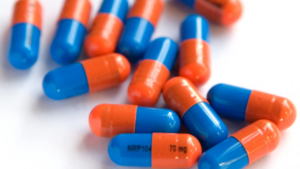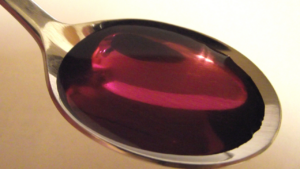Understanding the Side Effects of Oxycodone
The opioid epidemic has affected the lives of millions of Americans since the 1990s. Opioids are a group of drugs consisting of substances like prescription painkillers, heroin, synthetic opioids such as fentanyl, codeine, and more. Prescription painkillers, like oxycodone (OxyContin), gained steam a little more than 20 years ago. According to the Centers for Disease Control and Prevention (CDC), “The first wave [of the epidemic] began with increased prescribing of opioids in the 1990s, with overdose deaths involving prescription opioids (natural and semi-synthetic opioids and methadone) increasing since at least 1999.” The problem of opioid over prescription in Ohio hasn’t gone away. In 2018, Ohio providers wrote 53.5 opioid prescriptions for every 100 persons which is higher than the average U.S. rate of 51.4 prescriptions. As a result, opioid overdoses started to increase across Ohio and the country. People also started to realize how addictive these drugs are. In 2017, 1.7 million people suffered from an addiction to prescription painkillers. Furthermore, around 21% to 29% of people prescribed opioids for chronic pain misuse them, 4% to 6% eventually move on to heroin, and 8% to 12% of people using an opioid for chronic pain will develop an opioid use disorder (OUD). Drugs like oxycodone can dramatically affect your life. But even if you’re addicted, hope is out there for you. The first step is realizing you have a problem. Let’s take a look at the side effects of oxycodone, what OUD looks like, and how you can take your life back if you have an OUD.
What Is Oxycodone?
According to the Drug Enforcement Agency, oxycodone is a semi-synthetic opioid drug prescribed for pain as Tylox, Percodan, or OxyContin. It’s derived from the poppy plant and has a high potential for misuse. On the streets, it is known as:
- Kicker
- OC
- Hillbilly Heroin
- Ox
- Roxy
- Oxy
- Perc
Typically, oxycodone is taken in a tablet form that is either swallowed, chewed, dissolved in water and injected, or crushed and snorted. The drug usually comes in either 10-, 20-, 40-, or 80-milligram tablets. Oxycodone is misused because of the euphoric (pleasurable) effects it produces. Over time, those who misuse oxycodone will need more of the drug to feel its effects. This is a big reason the drug is so addictive. Just because oxycodone produces feelings of pleasure and relaxation doesn’t mean it doesn’t have its negative side effects as well. You should never take oxycodone without a doctor’s prescription, at dosages higher than recommended, or if you have certain medical conditions or are in recovery from OUD.
The Side Effects of Oxycodone
Oxycodone isn’t for everyone. The University of Michigan (UM) explains that you should refrain from taking oxycodone if you have asthma or breathing problems, or if you have a blockage in your intestines or stomach. Typically, it also isn’t approved for those under the age of 18 and should never be given to a child under the age of 11. You should always consult with your doctor before taking oxycodone. You should tell your medical professional if you:
- Have a drug or alcohol addiction
- Have a history of seizures
- Have a history of head injuries
- Have breathing problems
- Have sleep apnea
- Have liver or kidney disease
- Have gallbladder, pancreas, or thyroid problems
- Have problems urinating
- Are pregnant or plan to become pregnant
- Are breastfeeding
UM says, “Opioid medicine can slow or stop your breathing, and death may occur. A person caring for you should seek emergency medical attention if you have slow breathing with long pauses, blue-colored lips, or if you are hard to wake up.” Similarly, if you have an allergic reaction to oxycodone, such as problems breathing, hives, or swelling, call 911 immediately. Common side effects of oxycodone include:
- Headache
- Sleepiness
- Dizziness
- Tiredness
- Stomach pain
- Nausea
- Vomiting
- Constipation
If you’re experiencing any of these more serious side effects, seek medical attention right away:
- Slow heart rate
- Loud breathing
- Weak pulse
- Confusion
- Irregular behavior
- Seizure
- Breathing that stops during sleep
- Lightheadedness
- Loss of appetite
- Shallow breathing
- Agitation
- Problems walking
- Fever
- Sweating
- Chest pain
- Overdose
While taking oxycodone, you should always refrain from driving or operating machinery, or mixing it with other drugs. If you have any specific questions, talk to your doctor.
Signs of Opioid Use Disorder (OUD)
If you’re not sure if you have OUD, there are a few ways to spot it. According to the CDC, OUD is “sometimes referred to as ‘opioid use or dependence’ or ‘opioid addiction.’ OUD is a problematic pattern of opioid use that causes significant impairment or distress.” In 2016, a CDC report said 11.5 million people in the United States misused prescription painkillers. Common signs of OUD include:
- Weight loss
- Inability to stop taking opioids
- Changes in sleep patterns
- Tiredness
- Financial problems
- Uncontrollable cravings for opioids
- Removing oneself from friends and family
- Stealing from people to obtain opioids or money to buy opioids
- Withdrawal symptoms when not using opioids
According to Johns Hopkins Medicine, “Opioid use disorder may be diagnosed by a doctor. Someone struggling with opioid use disorder may not display symptoms right away. However, over time, there may be some signs that they need help.” Withdrawal symptoms from opioids can be very uncomfortable, which is why many people turn back to the drugs. Symptoms of oxycodone withdrawal can include:
- Anxiety
- Muscle aches
- Sweating
- Runny nose
- Agitation
- Diarrhea
- Abdominal pain
- Goosebumps
- Nausea
- Vomiting
- Dilated pupils (black part of the eyes enlarged)
- Problems sleeping
Symptoms of withdrawal usually begin no later than a day after the last use. If you are withdrawing from opioids, it’s recommended that you seek professional treatment to manage the symptoms. This can help you get past the first hurdle on your way to recovery much more comfortably.
What Does an Oxycodone Overdose Look Like?
If you believe you or someone you know overdosed on oxycodone, call 911 immediately. According to the U.S. National Library of Medicine, “Oxycodone overdose occurs when someone intentionally or accidentally takes too much medicine containing these ingredients. A person may accidentally take too much of the medicine because they are not getting pain relief from their normal doses. There are several reasons why a person may intentionally take too much of this medicine. It may be done to try to hurt oneself or to get high or intoxicated.” Symptoms of an oxycodone overdose include:
- Paleness or clammy skin
- Body goes limp
- Vomiting or gurgling noises
- Slowed breathing
- Slowed heart rate
- Fingernails or lips have turned a blue or purple color
- Passing out and being unable to wake up
You’re at risk of an oxycodone overdose if you take it illegally, at dosages higher than prescribed, mix it with other substances such as alcohol, are older than 65, or have certain medical conditions.
A Look at Medication-Assisted Treatment (MAT)
MAT is a tool used to treat those battling OUD. The U.S. Food and Drug Administration (FDA) says, “Medication-assisted treatment (MAT) is the use of medications in combination with counseling and behavioral therapies, which is effective in the treatment of opioid use disorders (OUD) and can help some people to sustain recovery.“ Currently, there are three drugs approved to treat OUD, including buprenorphine, methadone, and naltrexone. The FDA explains that each of these medications has been demonstrated to be both safe and effective when combined with counseling and behavioral health support. With millions of people battling OUD, the ultimate goal of MAT is to improve survival rates, decrease illegal opioid use, keep more people in treatment, improve the ability to maintain or gain employment, and improve birth outcomes for women. MAT has also been shown to help lower the risk of contracting HIV and hepatitis C.
Identifying Co-Occurring Disorders
Co-occurring disorders are common for people with substance use disorders, such as OUD. Having co-occurring disorders means having both a substance use disorder and a mental health disorder. The Substance Use and Mental Health Services Administration (SAMHSA) says, “People with mental illness are more likely to experience a substance use disorder than those not affected by a mental illness. According to SAMHSA’s 2018 National Survey on Drug Use and Health, approximately 9.2 million adults in the United States have a co-occurring disorder.” Common mental health disorders that coexist with OUD include:
- Bipolar disorder
- Schizophrenia
- Anxiety and mood disorders
- Depression
- Post-traumatic stress disorder (PTSD)
- Attention-deficit hyperactivity disorder (ADHD)
There are many theories as to why co-occurring disorders are so common. As reported by the National Institutes of Health, there are three possibilities. One of the possibilities is that substance use disorders contribute to mental health disorders. For example, certain substances may change the way the brain operates, making it more likely to develop a mental health disorder. Another possibility is that mental health disorders contribute to substance use disorder. Some people may turn to drugs like oxycodone to deal with a mental health disorder. Lastly, both disorders may have common risk factors. According to the NIH, “Research suggests that there are many genes that can contribute to the risk of developing both a substance use disorder and a mental illness. For example, some people have a specific gene that can make them at increased risk of mental illness as an adult if they frequently used marijuana as a child. A gene can also influence how a person responds to a drug – whether or not using the drug makes them feel good. Environmental factors, such as stress or trauma, can cause genetic changes that are passed down through generations and may contribute to the development of mental illnesses or a substance use disorder.” Professional treatment can help you learn how to manage a co-occurring disorder, which is crucial when it comes to long-term sobriety.
Your Addiction Doesn’t Define You
“In spite of discouragement and adversity, those who are happiest seem to have a way of learning from difficult times, becoming stronger, wiser and happier as a result.” – Joseph B. Wirthlin Life is full of obstacles. If you’re currently battling OUD, please understand that recovery is possible. If you’ve failed time and time again, do not give up. You have the power to overcome. You are stronger than you know. It’s also important to remember that you’re not alone. Even if you feel like you’re just treading water, there’s a lifeline in the distance waiting to pull you back to shore. Do not hesitate to seek that lifeline. You can receive treatment for oxycodone side effects and addiction, and you can take your life back.
Vertava Health – Ohio Is Here for You
Here at The Bluffs, we understand your situation is unique, which is why we create Oxycodone addiction treatment plans just for you. Our inpatient oxycodone rehab program will address the symptoms of your addiction and daily-life contributors that may affect it. We use evidence-based treatments like cognitive behavioral therapy and dialectical behavior therapy to help change thoughts and behaviors that lead to unwanted or unhealthy habits. We also offer recreational activities as a healthy alternative to oxycodone use. No one should ever have to face addiction alone. Whether it’s you or a loved one, we’re here to help every step of the way. Don’t let addiction control your life. Call us today at (888) 481-7821.
Frequently Asked Questions
How long does it take for the oxycodone to kick in? Typically, it takes oxycodone anywhere from 30-60 minutes to kick in. The effects usually wear off after four to six hours. Remember, only take oxycodone under a doctor’s supervision with a prescription, do not take more than prescribed, and seek medical attention if you are having any negative side effects. Does oxycodone make you sleepy? Oxycodone can cause a few different side effects, including sleepiness. Some side effects may be more severe than others, which is why misuse and addiction are so dangerous. Possible side effects include:
- Headache
- Sleepiness
- Dizziness
- Tiredness
- Stomach pain
- Nausea
- Vomiting
- Constipation
- Slow heart rate
- Loud breathing
- Weak pulse
- Confusion
- Irregular behavior
- Seizure
- Breathing that stops during sleep
- Lightheadedness
- Loss of appetite
- Shallow breathing
- Fever
- Agitation
- Problems walking
- Sweating
- Chest pain
- Overdose
What are co-occurring disorders? Co-occurring disorders are the combination of a substance use disorder and a mental health disorder. These are common. Common mental health disorders that coexist with OUD include depression, anxiety, PTSD, ADHD, and schizophrenia.







